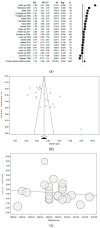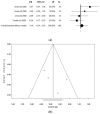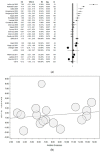Extent of Primary DNA Damage Measured by the Comet Assay in Health Professionals Exposed to Antineoplastic Drugs: A Systematic Review and Meta-Analysis
- PMID: 31947621
- PMCID: PMC7013773
- DOI: 10.3390/ijerph17020523
Extent of Primary DNA Damage Measured by the Comet Assay in Health Professionals Exposed to Antineoplastic Drugs: A Systematic Review and Meta-Analysis
Abstract
Background: Antineoplastic drugs (ANDs) are a broad group of chemicals showing, at the same time, carcinogenic effects. The potential, albeit true, risk of side effects cannot be accepted, especially if resulting from occupational exposure. The aim of this study was to evaluate the association between occupational exposure to ANDs and the extent of primary DNA damage in health professionals.
Methods: A systematic review and meta-analysis was conducted according to the Preferred Reporting Items for Systematic Reviews and Meta-Analyses guidelines. PubMed/Medline, Web of Science, and Scopus were used to perform the literature search. The databases were examined in July 2019. Sub-group, moderator, and cumulative analyses were conducted. The trim and fill method was used in the case of potential publication bias.
Results: Twenty studies were included in the qualitative analysis, and 19 in quantitative evaluation. The pooled effect size was 1.27 [(95% confidence interval (CI) = 0.66-1.88), p = 0.000] based on 1569 subjects. The moderator analysis by duration of exposure showed a positive association between duration of exposure and primary DNA damage.
Conclusions: This systematic review clearly shows a significant association between occupational exposure to ANDs and the extent of primary DNA damage in health professionals. Considering these results, health professionals should be warned against this potential occupational risk.
Keywords: antineoplastic drugs; comet assay; health personnel; occupational exposure; single-cell gel-electrophoresis.
Conflict of interest statement
The authors declare no conflict of interest.
Figures













References
-
- Alexander S.F. Medical report on the Bari Harbor mustard casualties. Mil. Surg. 1947;101:1–17. - PubMed
-
- Gianfredi V., Acito M., Salvatori T., Villarini M., Moretti M. Use of Micronucleus Assays to Measure DNA Damage Caused by Cytostatic/Antineoplastic Drugs. In: Fenech M., Knasmuller S., editors. Issues in Toxicology. Royal Society of Chemistry; London, UK: 2019. pp. 601–617.
-
- IARC . A Review of Human Carcinogens. Part A: Pharmaceuticals. IARC Monographs on the Evaluation of Carcinogenic Risks to Humans. Volume 100 International Agency for Research on Cancer; Lyon, France: 2011.

